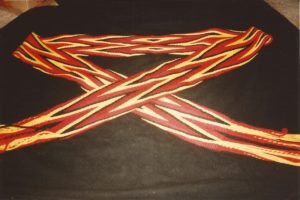Come and learn to fingerweave. We will create a finger woven hat band. We will work in the diagonal pattern. Different colors of yarn will be supplied. Learn to finish off your hat band in a few different ways. If time permits, we will start another hat band and learn the chevron pattern.

Class Time: 10:00 – 3:00-4 hours of instruction, materials.
Cost: 50.00 per person minimum of 6.
You can come and camp out the night before for a fee of 15.00. This gives someone who needs to travel a distance a chance to come and enjoy nature in the boreal forest. Please come self contained with your shelter and food. Water will be provided. Cooking over a fire can be done at the main campfire or you can bring your camp stove. If you wish to use one of the shelters or rent the cabin at the course location, please visit the Rentals page or contact us.
If you have a group who wish to book a Fingerweaving Class or any other class, please give us a call to make arrangements. We offer many different class subjects. Please visit the Karamat Experiences page to see all possible classes. All classes and rentals must be booked in advance.
About Fingerweaving
It’s important to realize that what you are learning is not a craft. You are learning an art with cultural significance to the Metis. Sashes are a cultural symbol of Metis identity. They are often worn at special events such as weddings, festivals, and graduations. Sashes are given as special gifts. In 1998, the late Metis Senator John Boucher presented Nelson Mandela with a sash during his visit to Canada. While many other cultures create sashes, the Metis widely embraced the art. Families often used the same colours for their sashes which would help identify who they were, much like the Scottish tartans.
Sashes varied in size, design, and colour, with most being about 15 cm wide and two metres long, and using 300 to 400 threads. With the introduction of sash manufacturing by the Hudson’s Bay Company, the art of fingerweaving was almost lost.
There are many uses for the sash. The most common is as a belt. During the fur trade, Metis voyageurs wore capotes and needed sashes to hold them closed. It was used as a rope, a harness, and the threads could be used as an emergency sewing kit. By folding it in half, it could be used as a pocket to hold small items. It was used as a wash cloth and a towel. By securing the sash around the forehead and heavy packages on the back, voyageurs were able to use the sash as a tumpline. Some sacks could be 90 lbs, and some voyageurs would carry a couple on their backs at once.
Courtesy of the Gabriel Dumont Institute – Virtual Museum
